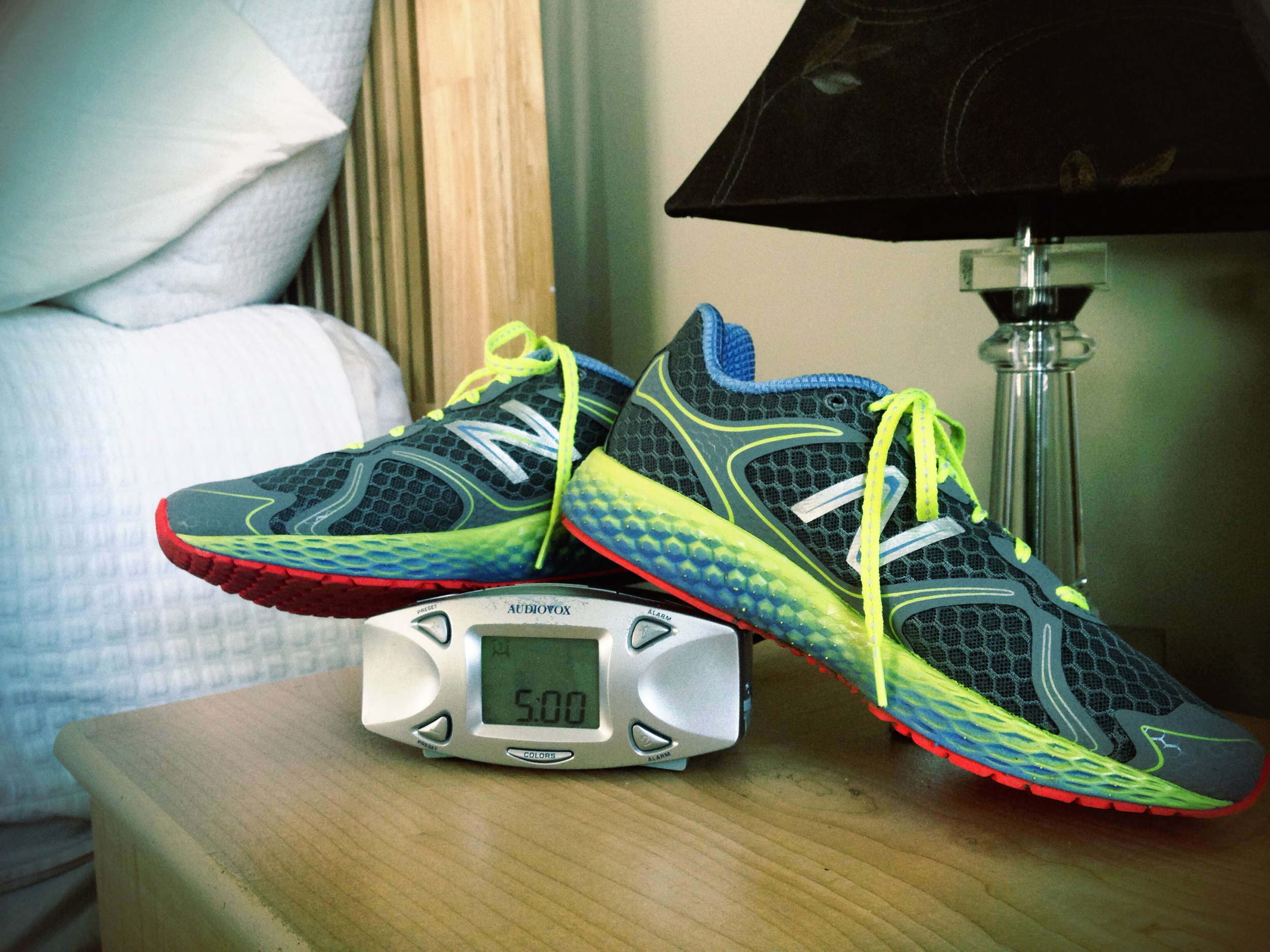7 Motivational Tips for Early Morning Runs
/ Today’s workout: 7 miles easy + strength training later at the gym
Today was one of those mornings. One of those mornings where that snooze button looks oh-so-tempting and your sleep-deprived brain starts to rationalize why you should skip your run. (“You ran yesterday!” “Skipping ONE run won’t hurt…” “I’m sure you can find time to fit it in later!!”) For me the sluggishness this morning was a result of almost hourly wakeup calls throughout the night by my little ones and the fact that I knew it was going to be HOT and HUMID even at 5am. Most runners are familiar with our brain’s attempts to sabotage our running schedule, whether through sleeping in or that extra glass of wine or two at dinner the night before a run. But I find that once I’m out the door, the early wake up time and the run itself isn’t nearly as bad as I’d feared – and I’m always proud of myself when I finish those runs that I didn’t particularly want to start.
Today’s workout: 7 miles easy + strength training later at the gym
Today was one of those mornings. One of those mornings where that snooze button looks oh-so-tempting and your sleep-deprived brain starts to rationalize why you should skip your run. (“You ran yesterday!” “Skipping ONE run won’t hurt…” “I’m sure you can find time to fit it in later!!”) For me the sluggishness this morning was a result of almost hourly wakeup calls throughout the night by my little ones and the fact that I knew it was going to be HOT and HUMID even at 5am. Most runners are familiar with our brain’s attempts to sabotage our running schedule, whether through sleeping in or that extra glass of wine or two at dinner the night before a run. But I find that once I’m out the door, the early wake up time and the run itself isn’t nearly as bad as I’d feared – and I’m always proud of myself when I finish those runs that I didn’t particularly want to start.
But there are definitely days like today, where I’m tired and grumpy before I even lace up my shoes, that I need a bit of an extra boost. Here are the tips I reach for when I’m trying to find that motivation to get out the door:
1) Buddy Up – This is the number one tip for me – and the one that makes it the easiest to get out the door no matter how I am feeling. If I’ve called a friend and promised to meet someone for a run, I’m going to show up. It’s a lot harder to ignore that alarm when you know someone is waiting on you. And it’s also a happiness boost when you know you’ve got a friend to run with to make the miles fly by.
2) Set a delayed alarm – I set two alarms each night. One is right by my bed and is at the time I want to wake up. The other one is set for 5 minutes later, and is far enough away that I have to get out of bed and go walk to it. In order not to wake up (and therefore irritate) my husband, I’ve got to turn off the first alarm quickly, and then get out of bed and turn off that second alarm before it goes off. Once I’m up out of bed, it’s easier to get dressed and ready to run.
3) Shoes on alarm clock – I like this one in theory (the first thing you touch is your shoes so you’d better get up and go run!) and it may work for some folks, but all I’ve managed to do is knock over my shoes in my attempt to turn off my alarm. What I like instead is to lay out everything I need the night before (shoes, socks, outfit, body glide, etc.). I also put out all of my stuff in one spot downstairs (watch, headlamp, water bottle, etc.) so that I can grab it and go without asking my still-sleepy brain to think too much.
4) Make a playlist – A new music playlist (or Pandora station) or even a great book on tape can sometimes get me through a motivational dry spell. If I know I have new tunes waiting on me in the morning, it’s often enough to make me a bit more excited about getting out the door. If it’s not safe for you to run with headphones where you live, save this one for the treadmill.
5) Run a new route – I’m pretty limited as to what routes I can run from my house, so occasionally I’ll spice things up by driving 10-15 minutes to run somewhere different. While getting up even earlier to fit in the drive time isn’t always fun, I’m always happy to run somewhere new since it livens things up a bit. If you don’t have time to drive, try running your normal loop in reverse.
6) Plan a reward – Know you have a tough week of training coming up? Or a very challenging workout? Promise yourself a little “reward” for making it through. If coffee or chocolate is your favorite, treat yourself to something yummy. If you’ve been eyeing a new piece of workout clothing (and your budget allows!), go buy it after you knock out a particularly tough week. My “treat” is usually a cup of Starbucks later in the morning after I’ve completed a tough tempo run that I’ve been dreading.
7) Give yourself a challenge – This can be as simple as “run my standard 5-mile loop a minute faster than yesterday” or “spot 5 different animals on my run”. I was lacking in motivation recently and decided to issue myself the challenge of taking a photo (using my phone) of something on each run that made me smile or that I’d consider beautiful.
These are some of the things that work for me, but I’d love some more ideas!
What tricks do you use to get yourself up and out the door when your motivation is lagging?







